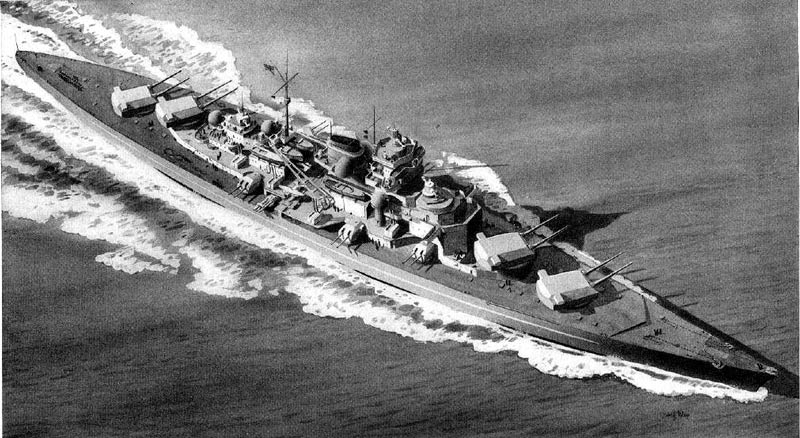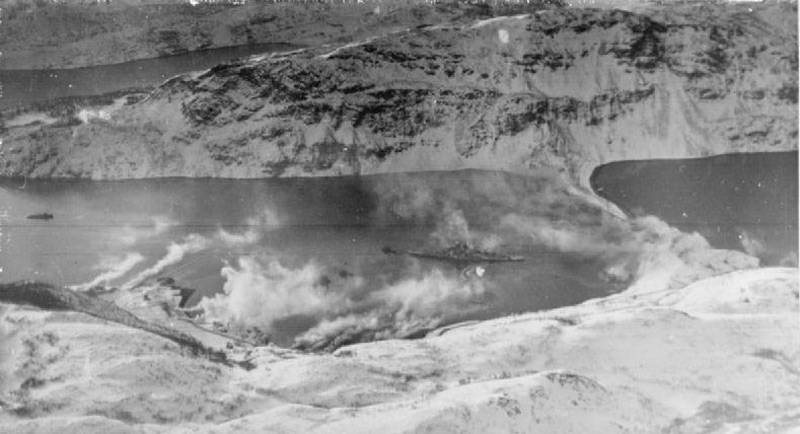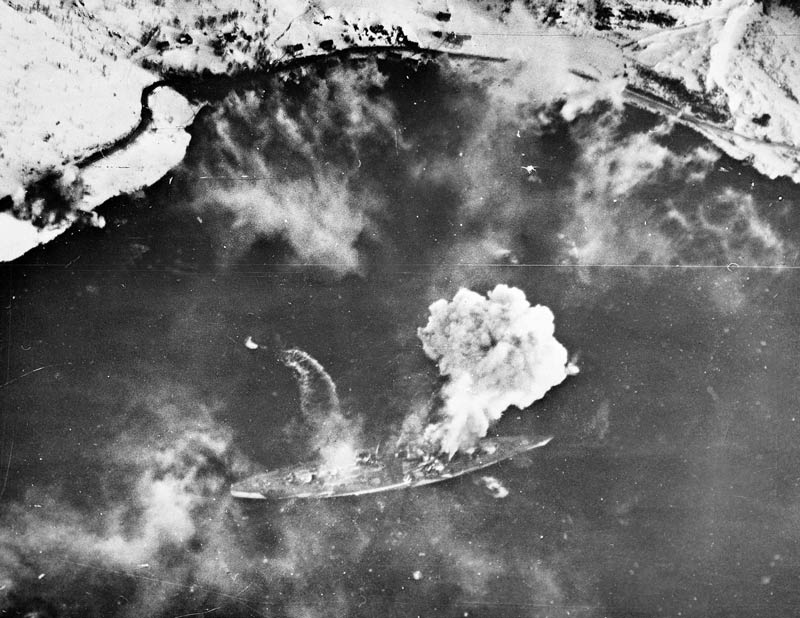
Bristling with weapons, the German battleship Tirpitz was launched in 1939. [Wikipedia]
Tirpitz was a massive ship launched in 1939. It was 251 metres long, had eight 15-inch guns and could carry four aircraft and 2,000 crew. At 39,000 tonnes, it was built to intimidate.
During the Second World War, Tirpitz was strategically stationed by the Germans in the fiords of Norway to prevent Allied convoys from reaching the Soviet Union, to discourage an Allied invasion of Scandinavia, and to tie up the Allied navies in a deadly game of cat and mouse.
“If it had come out at any time, it could have decimated a convoy,” said Albert Edward Revie of Algonquin, in one of several Memory Project interviews quoted here.
British Prime Minister Winston Churchill called Tirpitz ‘The Beast’ and declared its destruction of utmost importance. It took four years.
“If it had come out at any time, it could have decimated a convoy.”
Tirpitz rarely emerged from its safety net, but the mere threat caused consternation for the Allies. “Simply by positioning herself in the Norwegian fiords, she had become a ‘fleet in being,’” wrote Shawn Cafferky in Canadian Military History in 2010. “The British were forced to devote a large proportion of their naval resources to prevent her from breaking out into the Atlantic or raiding convoys bound for Russia.”
Fog and cloud frequently obscured the fiords, to Tirpitz’s advantage. RCAF pilot Bruce MacKenzie was tasked to “provide a deterrent to the battleship Tirpitz in the event she approached [British] shores looking to do surveillance and sink Allied vessels. At times we would return…only to find the runway thick with fog…I suppose that is what is meant by ‘coming in on a wing and a prayer.’ We did both.”
Tirpitz capitalized on the cover provided by nature by creating artificial fog and covering the deck with trees to hide its movements and confound search efforts.

Tirpitz produced artificial fog to hide its position. [Wikipedia]
“On several occasions, we escorted aircraft carriers to that area who flew off bombers, trying to damage the Tirpitz…but they couldn’t sink it,” said Revie.
In September 1943, the battleship was attacked by six midget submarines which put the ship out of action for more than six months, but it did not sink. And it survived attempts to destroy it while it was under repair.
“In the spring of 1944, intelligence had found out they were getting ready so that they could go back to sea,” recalled Andrew Irwin, a navigator’s yeoman aboard Algonquin. “So there was a concerted effort on the part of the Home Fleet to keep it holed up.”
The battleship survived three Allied operations between April and August. Many times, Algonquin and Sioux escorted aircraft carriers from which bombers were launched against Tirpitz from March to September 1944. On April 3, the Canadian destroyers were on hand for Operation Tungsten.

Tirpitz under attack by British aircraft launched from carriers on April 3, 1944. [Wikipedia]
The Canadian destroyers were there in July, when 44 dive bombers and 40 fighters took off from three aircraft carriers in Operation Mascot. But they were detected by radar and Tirpitz put up a smoke screen. Three British aircraft were destroyed.
Operation Goodwood, a succession of raids in one week involving 120 bombers and 97 escort fighters, was unable to inflict significant damage on Tirpitz, with a loss of 17 aircraft, a sunk frigate and a badly damaged escort carrier.
“Each of these attacks was a major battle involving thousands of personnel on both sides,” wrote Nick Dowling in “The Hunt for Tirpitz.”
Algonquin and Sioux were on convoy escort duty when Tirpitz finally bought it.
Thirty Lancaster heavy bombers of the RAF scored two direct hits on Tirpitz with Tallboy bombs on Nov. 12, 1944. The ship began to list and the captain ordered crew to abandon ship. Shortly afterward, the ammunition stores magazine exploded, killing many crew in the water and aboard.

Tirpitz capsized following the RAF attack of Nov. 12, 1944. [Wikipedia]
Advertisement





















